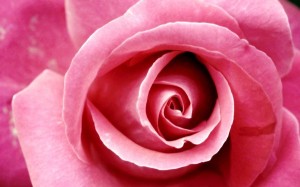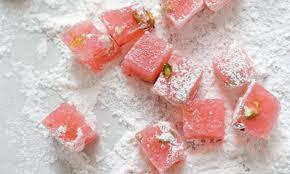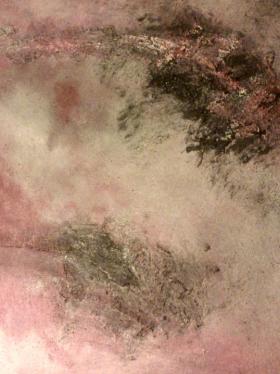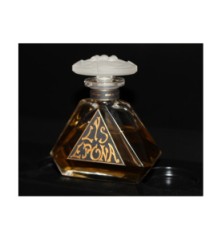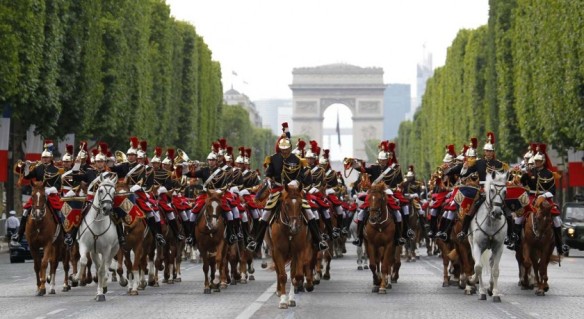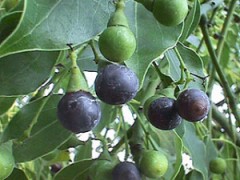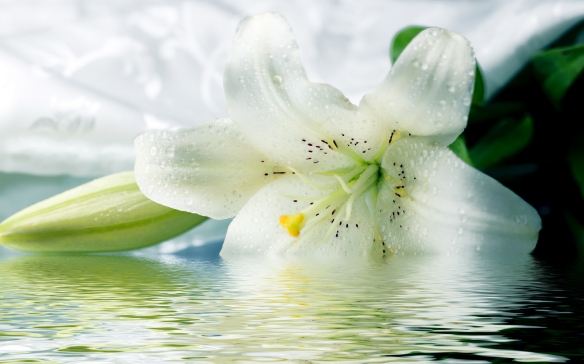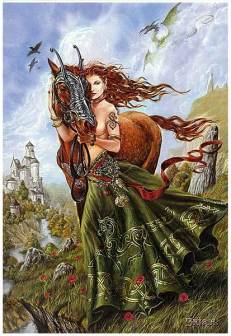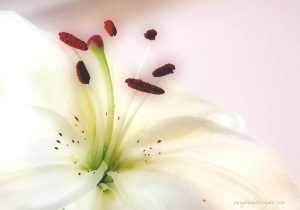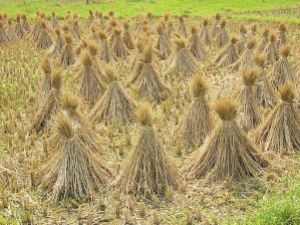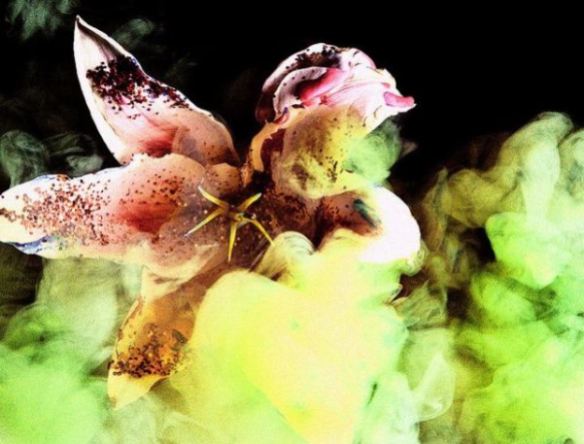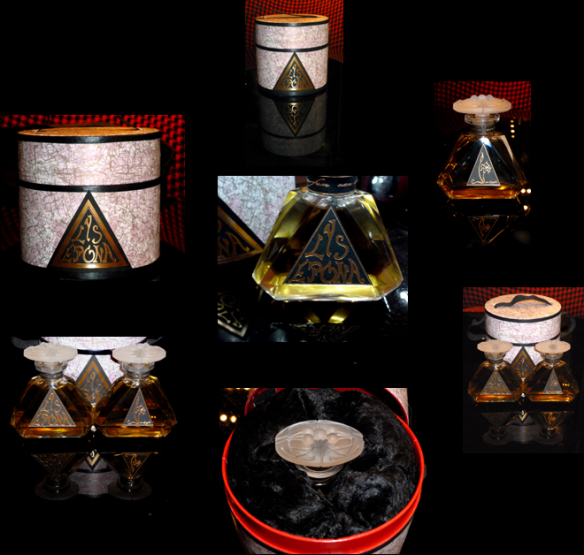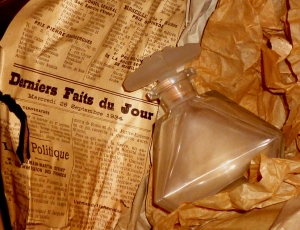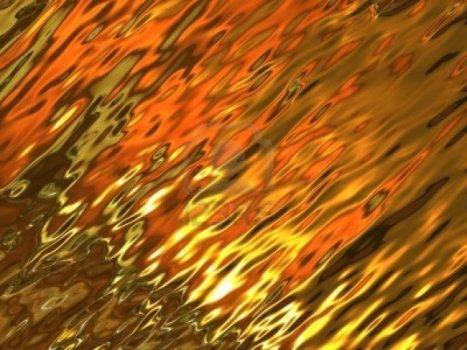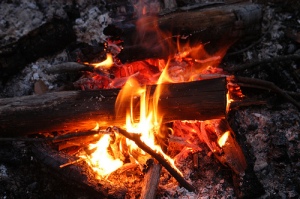“The night is dark, and full of terrors.”
That is one my favorite quotes from the television series, Game of Thrones, and I often come up with fun variations for different occasions. It’s a line which sticks in my head, so I wasn’t surprised when it popped back up just before I began testing Black, the new, about-to-be-released fragrance from one of my favorite perfume houses, Puredistance. The luxury brand talks about how the scent was inspired by “the concept of black,” and about how it is a “mysterious fragrance that stays in the shadow, giving away – only every now and then – part of its nature.”
Upon reading that part of the press release, and seeing the image sent by the company, all I could think of was, “the night is dark (black), and full of luxury.” Well, not quite. As it turns out, Black is indeed an extremely luxurious fragrance that smells very expensive, but I found it to be as purple and pink as humanly possible. At one point, it evoked fluffy pink clouds, and I almost expected a chubby cherub to be sitting on one and offering me turkish delight. For me, “Black” is the absolute furthest thing from its name, and is not my personal cup of tea. It’s not a bad fragrance by any means — in fact, it’s well done and clearly emanates luxury — but we all have subjective tastes or things that we struggle with, and I struggled quite a bit with Black.
Like all of Puredistance’s fragrances, Black was created by a master perfumer, in this case, Antoine Lie, and is the very highest perfume concentration, an extrait de parfum. Black clocks in at 25% perfume oil, a figure that is surpassed only by Puredistance’s exquisite floral, Opardu (which has 32%). Black will be released at the start of December, and is described as follows:
Puredistance Black is an understated elegant and mysteriously charming perfume inspired by the concept of BLACK; a concept that for centuries has been associated with secrets, mystery and style.
Puredistance BLACK is created in Paris by the famous French Perfumer Antoine Lie based on a concept of Puredistance founder Jan Ewoud Vos. The essence of the concept was to create a perfume that is close to the wearer and releases sensual and elegant scent layers in a whispering way – without shouting. A mysterious fragrance that stays in the shadow, giving away – only every now and then – part of its nature.
As part of the whole concept of mysterious shadows, Puredistance wants you to treasure the “beauty of the unknown,” and merely describes the scent as one that is more “masculine and oriental” than Puredistance “I.” The company is keeping secret Black’s perfume notes, saying only that you should “Envision, Smell, Feel. Don’t analyse.” If you’re a regular reader, you all know how well I manage not to analyse things…. It’s hopeless. I was incapable of just smelling, feeling, letting go and not analysing with the uber-luxury brand, JAR, and it’s not possible here, either. It simply is not my personality or forte in life, given my obsessiveness with both facts and details.
So, based on what I smelled, let me give you my guess of the notes in Puredistance Black:
Ginger, cardamom, absinthe wood (wormwood), saffron, rose, patchouli, myrrh, opoponax (sweet myrrh), amber, sandalwood (not from Mysore), and benzoin.
What I’m less absolutely certain of is the possible inclusion of oud, a tiny touch of elemi wood or guaiac as an additional source of woody smoke, and a drop of vanilla. It’s extremely possible, but I wouldn’t bet my life on it.
Puredistance Black opens on my skin with a blast of cardamom, immediately followed by ginger, amber, absinthe wood, incense, saffron, patchouli, and a whisper of rose. There is a balanced sweetness, a suggestion of sandalwood, and a saffron that is neither buttery nor hot, but wonderfully spicy. The ginger adds a lovely, fresh, piquant bite that works beautifully with the sweeter notes and the woodsy notes.
Speaking of the latter, I guessed absinthe (or wormwood) for a few reasons. First, even before I tested the perfume and simply upon taking the vial out of its white, satin pouch, I was hit by an extremely strong blast of oud-like woodiness that was herbal, spicy, and green — too much so to be real agarwood. It was also extremely similar in smell to the wood note in Amouage‘s Fate Man, a fragrance that officially includes wormwood. On the skin, the woodsy notes was surprisingly less dominant and forceful than what was wafting out of the vial, but it felt even less than complete, total agarwood in nature. Absinthe shares a few cursory, initial similarities with oud, so that’s what I’m going on.
 The initial opening of Black in the first two minutes is lovely, but then, my nemesis takes over: purple, fruited patchouli. For all that I love black/brown patchouli, I despise the purple kind that is ubiquitous and everywhere in modern perfumery. A friend asked me the difference the other day, and I think my explanation may help some other people too.
The initial opening of Black in the first two minutes is lovely, but then, my nemesis takes over: purple, fruited patchouli. For all that I love black/brown patchouli, I despise the purple kind that is ubiquitous and everywhere in modern perfumery. A friend asked me the difference the other day, and I think my explanation may help some other people too.
For me, traditional (and rather 1980s) patchouli is brown/black in hue, with chewy undertones of sweet amber, spice, leather, wood, and incense smoke. The current, modern version of patchouli is purple in hue because it’s fruity, syrupy, jammy, incredibly sweet, and with grape and berry undertones. The very original type of patchouli is the 1970s, hippie kind that is really, really black, dirty patchouli and that people describe as a “head shop” scent. Some examples of fragrances with a strong purple patchouli note would be: almost every commercial, department store perfume containing “patchouli,” Marc Jacobs‘ Lola, Chanel‘s Coco Noir, Le Labo‘s Ylang 49, Frederic Malle‘s Portrait of a Lady, and, now, alas, Puredistance Black. An example of black/brown, more traditional patchouli would be something like Profumum Roma‘s Patchouly, Serge Lutens‘ Borneo 1834, Chanel‘s Coromandel, or Reminiscence‘s Patchouli. It’s not a long list at all because that sort of patchouli is incredibly uncommon nowadays.

Source: Tasty Yummies blog. (Link to website embedded within photo. For recipe for Concord grape jam, click on photo.)
I spent all this time outlining the specific smell and nature of purple, “fruit-chouli” because it is the heart of soul of how Puredistance Black manifests itself on my skin. No less than three minutes into the perfume’s development, the saffron-oud blast takes on an almost grape-y, berry, jammy overtone that is incredibly sweet. Five minutes in, I feel as though I’ve been covered by fruit syrup. Twenty minutes in, I feel as though I’ve been transformed into a berry tart with unctuous, cloyingly sweet, fruited, purple Smucker’s jam, then sprinkled with rose petals and a dusting of saffron. I have to be honest, I lost my appetite — and I hadn’t eaten in over 12 hours.
I wish there were a substantial counter-balance to the deluge of fruit-chouli in the opening hour. There is a herbal, woody note that flitters about like a tiny hummingbird, but it’s far, far underneath, and wholly unable to compete with the grape-y, berry onslaught that is stomping over my arm like a Panzer unit in full fury. I know my skin tends to amplify base notes, but this is a bit ridiculous. I think sadly back to that absolutely lovely opening with its spicy, gingered, slightly herbal, ambered woodiness, but it’s gone, smothered by unctuous, purple, saffron-rose-infused molasses. Even the absinthe gasps for air, then retreats to the corner to hide its head.

“Purple Velvet Gold Flakes” by *Will3style at Deviantart.com. http://will3style.deviantart.com/art/Purple-Velvet-Gold-Flakes-258099755
There is no salvation in low sillage, either. That promised description of a wispy perfume that “stays in the shadow”? Ha! Black’s opening is strong and potent, with significant sillage, wafting in a purple cloud almost a foot around me. I normally would be thrilled, but the fruit-chouli is starting to crush my spirit. For a whole hour, I’m drenched by jammy, grape-berry molasses, that is just lightly infused by particles of saffron-infused rose, incense, absinthe wood, and honeyed amber. The ginger is no longer noticeable, and neither is the cardamom.
It was with enormous relief that things start to slowly — very slowly — improve at the end of the first hour. The Smucker’s patchouli jam lessens fractionally, allowing the rose to finally come out properly from its gooey purple shadow. The rose is sweet, just slightly dewy, and pink in visuals. With each passing moment during the second hour, it takes on a weight of its own, and starts to diffuse the fruitedness of the perfume. The woody notes and light incense are also more noticeable, though they’re largely blended into the greater whole.
By the start of the third hour, Puredistance Black’s purple hues have turned into a gorgeous shade of pink. The perfume wafts about 2 inches above the skin, and has a soft, creamy texture like a fluffy cloud of saffron-rose. In fact, Black takes on a Turkish Delight, or loukhoum quality, though without any of the sugared powderiness often associated with that confection. The patchouli remains, but it is quite mild as compared to its original, completely nuclear blast. Instead, it merely adds to the loukhoum association with a soft touch of grape. It actually works perfectly and brilliantly now. The absinthe wormwood and touch of incense lurk in the shadows, leaving an image that is primarily that of a pink, fluffy, creamy cloud. I almost expect to see a pink-cheeked cherub sitting on one of them.
I mean it quite sincerely when I saw that I enjoyed this phase of Black. I really did. It reminded me of a significantly richer, creamier, more luxurious version of the drydown phase of Tom Ford‘s Noir de Noir. There, the syrupy, very baroque rose with saffron, truffle earthiness, and the merest, speckled touch of oud also turned into a loukhoum confection in its final stage, but there are big difference. Noir de Noir was much thinner at that point than Black, had an almost violet-y touch, and, more to the point, was extremely powdered in nature. I wasn’t particularly fond of the violet, vanillic powder of the drydown, and I’m relieved that Puredistance Black has none of it at this stage.
Even better, Black is infinitely deeper, smoother, richer, creamier, and more opulent. The perfume is fluffy, but rich; sweet but not excessive; and an utterly beautiful, creamy, deep, pink rose with just the right amount of fruited patchouli. There is also the very necessary touch of woodiness which Noir de Noir lacked in its drydown, adding a balance to the floral sweetness. Here, the woody element has the faintest flicker of herbaceousness, but, more importantly, a creamy smoothness that makes me wonder if there is generic, Australian sandalwood or cashmeran underneath.
Black remains as this lovely mix for a few hours with only minor alterations. For example, at the start of the fifth hour, the perfume drops to lie just barely above the skin. The herbal absinthe wood that continues to hide behind the floral loukhoum changes in strength, fluctuating from mild to weak on the overall scale of things. And there is a growing hint of something anisic that is rising to the surface.
At the 6.5 hour mark, however, Black begins to transform. It takes on a licorice undertone and slight whiteness which makes me think that it must have myrrh. It is a note which is known to display an anisic, herbal facet, in addition to a slightly churchy, cold, white, incense note. The latter is extremely subtle in Black, but it’s there as well. At the same time, there also is a flickering shade of something honeyed which resembles very much sweet myrrh or opoponax. In addition, Black is starting to show a slightly vanillic powderiness that makes me suspect the presence of benzoin. In its final change, the perfume has turned into a gauzy veil that sits right on the skin, though it is still easily noticeable and potent when sniffed up close.
Black still smells of a floral confection first and foremost, but the newcomers become increasingly noticeable. And, in all honesty, I’m not completely thrilled by the overall effect. There is a cloying undertone to the rose Turkish delight when combined with the anisic, slightly cold, white incense-y myrrh, the sweet myrrh, and the vanillic powder. It’s not helped by a new spiciness that faintly resembles All-Spice powder and/or star anise. In small doses and for a short period of time, the sum total is perfectly fine, but Black stays this way for hours on end. I found it a little fatiguing, if truth be told.
In its very final stage, starting at the 9th hour, Black turns into a whisper of sweet vanillic powder with rose, a vague blur of myrrh, a flicker of abstract woodiness, and an odd underlying tinge of sourness. It’s all a shadow of its former self, coating the skin like the sheerest, thinnest glaze. Black finally fades away about 14 hours from the start with four squirts from the small sample, and 15.25 hours with 5 medium sprays. (Note: My sample atomizer didn’t release the same amount as would be available from a regular bottle as it had a very small hole and a wonky release, so the quantity applied was not as large as those numbers may suggest. It would really be the equivalent of 3 small-to-medium smears from a dab vial, and 4 large ones.)
I tested Black twice, and I’m afraid I wasn’t very enamoured on either occasion. I don’t mind the middle phase, but I wasn’t crazy about the last one. And there aren’t words whatsoever to describe my reaction to the opening hour. As I said, I thought Black significantly and substantially improved at the start of the second hour, but the first one was rough.
Yet, it’s important to put my comments into context: I absolutely loathe purple, fruited patchouli. I try to grit my teeth and get over it when the note is minor, but when it is significant, substantial, and potent, then I simply can’t bear it. I don’t think others have quite the intensity of my reaction to fruit-chouli, which isn’t helped by having a skin chemistry that amplifies the note. In short, my reaction is very subjective and personal to me.
It’s also a reaction that is not even remotely common to others who have tested perfume. Black has generally been greeted with uniform admiration and liking, even by those who usually share my perfume tastes and skin chemistry. Take, for example, The Non-Blonde who writes, in part:
Puredistance is stepping into unexpected new territory with Black, a dark and romantic fragrance created by perfumer Antoine Lei[.] … Black [is] an oriental with an edge that could have come straight out of the labs at Amouage. […]
Puredistance Black holds my interest from the very first second. A medicinal camphoric note there that lets you know that the raw materials here are real and uncompromising. Soon it becomes honeyed and steeped in booze, making the maybe-oud go down easily and deliciously. Perfumes of this kind, from Amouage to By Kilian often use their sillage to assert themselves as luxury. Not here, though, and as the press materials stress– this is a feature, not a bug. And I have to say that I love it. Black is not exactly a skin scent but it lives and thrives on skin level; the emotional storm is very much there, manifesting itself for one’s own personal pleasure for a full day and night, just without broadcasting it to the world.
My reaction was also different from those who did detect the patchouli, but had a completely different perception of its nature. In a gushing rave, The Perfume Shrine described Black as follows:
a quasi-brutal opening with a tangy citric fruitiness allied to the darkest, earthiest patchouli possible, like snails coming out of the bush in the dusk, but the cloak of the night soon mollifies it with a woody cluster of honeyed plummy-cedar notes reminiscent of the Lutens canon and a “suede” orientalism. The sweet melange is also reminiscent of pipe tobacco, laced with a boozy aftertaste that lingers. (I hypothesize smoky cypriol/cyperus and vetiver should be featured too). Chewy, a meat course for non vegetarians. […]
Puredistance Black reminds me of the darkness and weirdness factor of Goutal’s Un Parfum Cheri, par Camille, fueled by an intense Indonesian patchouli grade replete with all its earthy chocolate and darkness “dirty” facets. […] Black would be also liked by those who appreciate Borneo 1834 and Bois de Violette or by oudh and tobacco fragrances fans, as the bittersweet oriental feel would appeal.
I’ve tested both the Lutens fragrances that she mentions, and I see absolutely no similarity between the patchouli in Borneo 1834 and Black. Not even remotely. As for Bois de Violette, I don’t think mere fruited sweetness with wood is enough to make the perfumes comparable in style. Clearly, we have very different skin and skin chemistry.
Patchouli — of any kind — isn’t mentioned at all by two bloggers with whom I generally have very similar perfume opinions, as well as perfume tastes. Take the lovely Caro of Te de Violetas who writes:
The initial impression is one of chaos: its fiery opening smolders with notes of chili pepper, cinnamon, and green cardamom, soon overlapped by the bitterness of saffron and absinthe. A smoky touch of oud dominates the blend for a while and brands its character. I am not especially devout of oud but the effect here is restrained and it suffices to cast a veil of mystery. The whole effect is opaque but lightweight and refined. As I near my nose to my wrist, I can’t shake from my head images of Bogart and Bacall. The progression is as smooth as velvet. As it turns softer, well into the drydown, vanilla, tobacco and tonka ensure a plushy sweetness but the darkness never completely fades away.
As a woman, I can wear Black more comfortably than the rugged M, but I still prefer to smell this on a beloved man or on a handsome stranger.
The Scented Hound also never mentions patchouli, though parts of his experience sound to me as though they involved both absinthe wood and myrrh:
WHAT I SMELL: Black opens with a sweet and deep incense and smoky accord. I want to say there’s some bergamot and what seems to be a bit of floraled honey mixed with the smokiness. That initial smokiness breaks away somewhat to reveal this almost butter like creamy light almond. But as soon as I notice that, the incense starts to waft up from the bottom again, this time with what seems to be a bit of sueded leather. There’s a bit of sour that makes an appearance that doesn’t detract, but like the smoke and incense, seems to pop in and out. After around 15 minutes it seems like there is a bit of peppered metallic that makes an appearance. Again, it comes and goes like all of the other notes which seem to intermix seamlessly without one note dominating. In the end you’re left with a very light, close to the skin, smooth and elegant slightly woody incensed perfume.
As all of this should make clear, Puredistance Black is different things to different people. All these reviews are dissimilar, though mine seems to veer furthest outside any common thread.
So, the bottom line is that you should try Black for yourself, and make up your mind. If, by chance you generally share similarities with my type of skin and perfume taste, don’t be put off by my review. For example, if you love Tom Ford’s Noir de Noir, or if you would like an even richer version of its drydown, you absolutely should consider Puredistance Black. I will only caution you on one thing: if you’re expecting another, darker, woodier version of Puredistance’s absolutely spectacular “M,” then you will be disappointed. They are nothing alike — and every reviewer who mentions “M” is absolutely consistent on that point.
Perhaps that is small part of why I struggled with Black. M happens to be one of my all-time favorite (modern) fragrances, an absolutely magnificent marvel that is in my Top Ten, and which I would bathe in, if it were possible. The chypre-oriental-leather-amber mix is also the perfect representation of my perfume tastes. I don’t do well with sweetness, and Black turned into a very extreme, very pink example of that. If I had experienced something actually black in hue, with smoky, woody, dark Orientalism, then I suspect M might have had some stiff competition. As it is, I’m afraid it doesn’t.
DISCLOSURE: My small vial of Black was provided courtesy of Puredistance. That did not impact this review. I do not do paid reviews, my opinions are my own, and my first obligation is to my readers.





